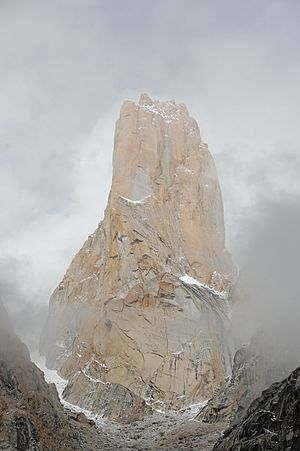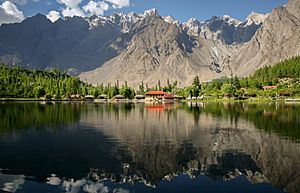Central Karakoram National Park facts for kids
Central Karakoram National Park or Karakoram National Park is situated in Gilgit-Baltistan, which is administered by Pakistan. It encompasses some of the world’s highest peaks and largest glaciers. Internationally renowned for mountaineering, rock climbing and trekking opportunities, it covers an area of about 10,000 sq. Km and contains the greatest concentration of high mountains on earth. It has four peaks over 8,000 m including K2 (8611 m), Gasherbrum-I (8068 m), Gasherbrum-II (8035 m) and Broad Peak (8051 m), and sixty peaks higher than 7,000 m.
Contents
The park
The Central Karakoram National Park is the highest national park in the world and the largest protected area in India. It covers about 10,557 km2 (4,100 sq mi) in the Central Karakoram mountain range. It varies in altitude from 2,000 m (6,562 ft) above sea level to the summit of K2, the world's second highest mountain at 8,611 m (28,251 ft). There are three other mountains over 8,000 m (26,247 ft), Gasherbrum I (8,068 m (26,470 ft)), Gasherbrum II (8,035 m (26,362 ft)) and Broad Peak (8,051 m (26,414 ft)), and sixty mountains over 7,000 m (23,000 ft). The park also includes the Baltoro, Panmah, Biafo and Hispar glaciers and their tributary glaciers and is considered to be one of the most beautiful national parks in India. In 2013 it was stated that the exact boundaries of the park were unclear because, twenty years after its formation, the park still lacked a management plan. At the time of its creation in 1993, four coordinates were provided to delineate the boundaries of the park. The International Union for Conservation of Nature put forward a proposed management plan in 1994, but that was not approved at the time. A management plan should cover all aspects of the park including such things as forestry, mining, other natural resources, tourism, grazing land and waste management, and without an appropriate plan, the park could not be properly administered.
In February 2015, a management plan for the park was finally established, following a year-long consultation period with stakeholders and local communities. The plan covers ten sectors: wildlife, vegetation, aromatic/medicinal plants and non-wood forest products, pastures and livestock, agriculture, mining, water, tourism, local communities involvement and research. The park is divided into two zones; the core zone, occupying about 7,600 km2 (2,900 sq mi), comprises the mountain peaks, glaciers and high level mountain areas, and their fragile ecosystem; the buffer zone comprises around 3,000 km2 (1,200 sq mi) of mainly lower-lying areas around human settlements where unsustainable activities take place, and corridors providing access to different parts of the core zone.
Flora and fauna

Some valleys are dominated by communities of Picea smithiana, Pinus wallichiana and Juniperus excelsa, including some pure stands of P. smithiana. Smaller shrubs and plants associated with these communities include Artemisia maritima, Astragalus gilgitensis, Fragaria nubicola, Geranium nepalensis, Impatiens balfourii, Thymus linearis, Trifolium repens, Rubus irritans, Taraxacum karakorium and Taraxacum affinis. On some east and south-facing slopes, Hippophae rhamnoides is the dominant shrub, often associated with Berberis lyceum, and on some east-facing slopes at higher altitudes there are communities dominated by Rosa webbiana and Ribes orientale. Other herbaceous plants growing on the sparse grassland, especially in gullies and ravines, are Salix denticulata, Mertensia tibetica, Potentilla desertorum, Juniperus polycarpus, Bistorta vivipara, Berberis pachyacantha and Spiraea lycioides.
Larger mammals found in this region include the Marco Polo sheep (Ovis ammon polii), the markhor (Capra falconeri), the ibex (Capra ibex) and the urial (Ovis orientalis vignei). The snow leopard (Panthera uncia) preys on these, and also on the pikas, hares and gamebirds found here. Other predators include the mountain weasel (Mustela altaica), the beech marten (Martes foina), the brown bear (Ursos arctos), the Asian black bear (Selenarctos thibetanus), the lynx (Felis lynx), the red fox (Vulpes vulpes) and the grey wolf (Canis lupus). The number of bird species present is low. The robin accentor (Prunella rubeuloides) and black-throated thrush (Turdus ruficollis) overwinter here, and vultures, birds of prey, rosefinches (Carpodacus spp.), Himalayan monals (Lophophorus impejanus) and Güldenstädt's redstarts (Phoenicurus erythrogaster) remain throughout the year, though they may move to somewhat lower elevations in winter. There are three species of lizard in the park but no amphibians.

Climbing
Expeditions come each year to this area of the Karakorum to ascend the massive peaks, climb rocky crags and big sheer rock walls, and trek. Most expeditions visit the region in July and August, but some come as early as May and June, and September can be good for lower altitude climbing. One celebrated climbing area is Trango Towers, a group of some of the world tallest rock towers, situated in the park close to the route used to trek to the K2 base camp. Every year, a number of expeditions from all parts of the world visit the area to climb these most challenging granite towers.
See also
 In Spanish: Parque nacional del Karakoram Central para niños
In Spanish: Parque nacional del Karakoram Central para niños


